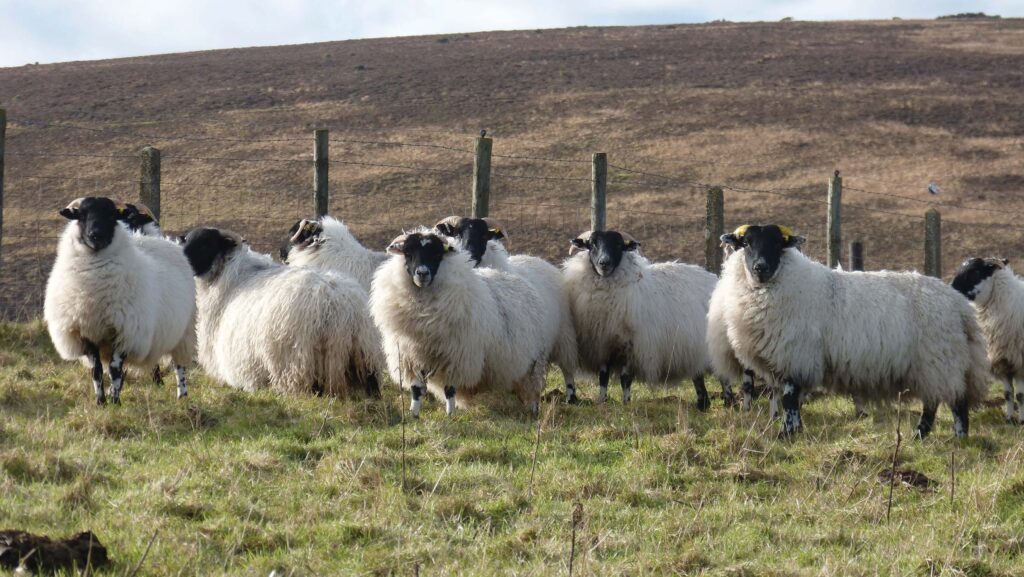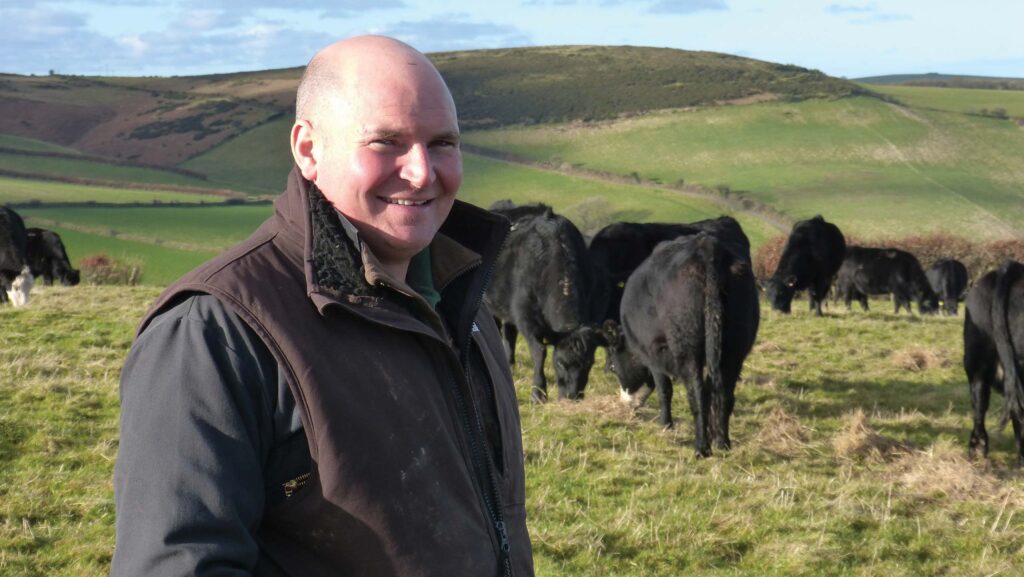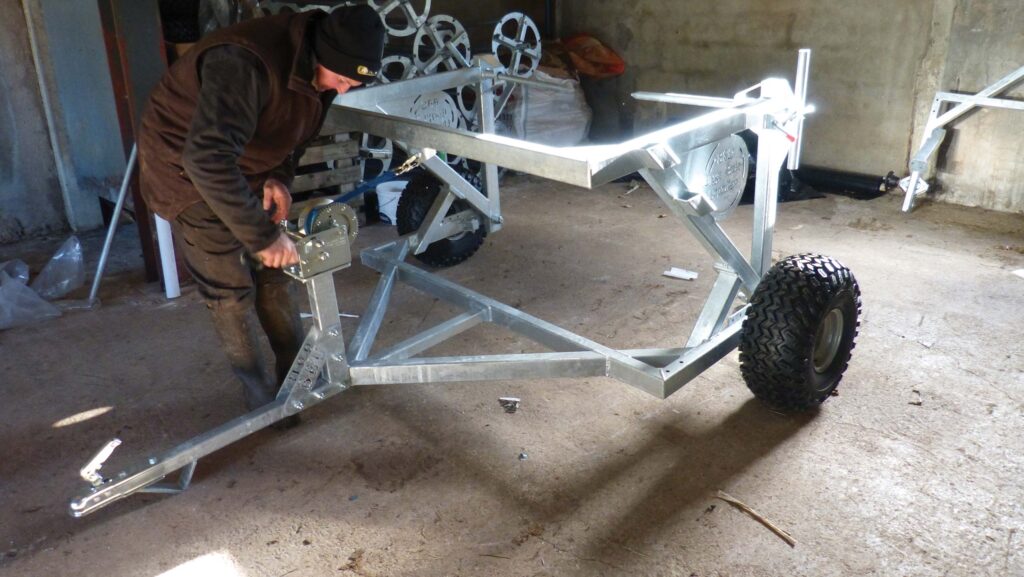Hill flock beats high-profit ewes amid suckler expansion
 © MAG/Michael Priestley
© MAG/Michael Priestley A hill flock has survived a major enterprise restructure on an Exmoor farm, which saw cow numbers increased at the expense of a profitable in-bye sheep system.
Only 150 shearlings remain from a flock of 1,150 in-bye ewes at Oaremead Farm, near Lynton, where the Burge family are doubling their 80-cow herd to 160-head.
Historically, the in-bye ewes made more than £30,000 profit a year, while the sucklers were “break even at best”, explains Tom Burge, who runs a family partnership with wife Sarah and parents Phil and Carol.
See also: Tips to help make beet and bale grazing work in a wet winter
However, a move to outwintering made the sucklers stack up, and the Burges decided to keep the hill flock going, as it operated on lower costs and lower labour, and was a resilient system.
While this seems at odds with wider trends in the British farming industry, Tom has budgeted to make £72,000 profit with the calves born this year.
“This will go some way to replacing the farm’s old Basic Payment Scheme cheque,” he explains.
“We found a cheaper way to run the cows, so something had to give with the sheep. The hill flock is much less work and that’s why the in-bye ewes are going.”
Farm facts: Oaremead Farm, near Lynton, Devon

Tom Burge © MAG/Michael Priestley
- 300ha of in-bye permanent pasture
- Access to one 1,200ha heather common with seven other graziers
- Privately renting a 320ha grass common and a 160ha heather common
- Farm in Higher Level Stewardship agreements
- Selling carbon through Regenerate Outcomes in the future
- 1,600-1,700ml annual rainfall
- Peaty hills and sandy loams lower down
- 40-pitch campsite
Previous system
Oaremead Farm produced Charolais-cross calves out of commercial Angus and Angus-cross cows for decades for the Exmoor Farmers Suckled Calf Rearers Association sale in nearby Cutcombe.
Typically, the 70-80-cow herd was housed in November or early December, calved in February and March and would not be turned out until May. Heifers were bulled as two-year-olds to calve at three.
The hill flock already had a long history of outdoor lambing, while the in-bye sheep have lambed outside since 2017 to reduce inputs.
The flock of 1,150 in-bye sheep was developed from a Highlander flock Tom started in 2006 and crossed to New Zealand Romney and Texel.
These in-bye ewes typically scanned at 175% and the best rearing rate was 164%, with the Burges budgeting on 1.5 lambs sold a ewe. Profit averaged £25-£30 a ewe.
The 500-ewe hill flock of Scottish Blackfaces would scan at 120% and rear about 100%. Most lambs would be sold as stores through Blackmoor Gate market, near Barnstaple.
Mindset change
Tom was already on a mission to strip out costs using rotational grazing.
He used the expertise of consultancy Precision Grazing to set up a paddock-grazing system, cutting out 50t of concentrate feed and 50t of fertiliser from the system.
He then embarked on a “regenerative journey”, learning about the soil, scrutinising inputs and employing a more natural approach to running livestock.
Liming has been reduced on some areas of the farm, while fertiliser use stopped completely in 2021.
“Liming is good farming practice, but we found no amount of lime would take some ground above 5.8pH. It seemed to naturally sit at that point.”
Instead of applying lime at 3.5-5t/ha (£170-£230/ha), Tom lets soil biology take over. “Science shows we can lift the pH of the soil with worms, and that saves on diesel and tractor use,” he reasons.
This same approach has been taken with the sheep, as the Scottish Blackfaces on the hill ground require fewer wormers, and manage without the pasteurella or toxoplasmosis abortion vaccines that the Highlander-crosses required.
They are only gathered for scanning, weaning, shearing and dipping, and lamb outside from mid-April.
“I hope a higher cow-to-sheep ratio manages parasites through grazing management, and using less wormer helps soil biology,” he says.
A lower input farm is important to Tom, who has other responsibilities: he enjoys knowledge transfer events and is a director of the Exmoor Hill Network and Exmoor Farmers Livestock Auctioneers.
Most importantly, he likes to keep Wednesday afternoons free to pick daughter Edith up from school.

Burge bale unroller © MAG/Michael Priestley
Bale grazing
A mob of 40-50 cows is now outwintered on 0.5ha (1.2 acres) of grass and one bale of hay. To reduce poaching, Tom built a bale unroller.
Drawn behind a quad bike, this spreads out the feed for the cows.
So impressed with the impact of this labour-saving device on his wintering system, he started making more, called them Burge Bale Unrollers, and has now sold more than 50 across the UK.
“The six-month [housed] winter was a major barrier to profit. By calving later and bale-grazing on deferred grass, we’ve turned the costs around,” says Tom. “We went six weeks without starting one of the tractors this winter.”
The system requires 700 bales – plus 100 spares – for all the cattle and hill ewes.
To improve species diversity and rooting depths of the bale-grazing fields, he is importing hay bales from stewardship fields to introduce wildflower and herb seeds.
Herd growth
Tom experimented with outwintering for three years before he took the plunge and expanded the sucklers significantly.
In 2023, he bought 28 in-calf heifers to grow his herd. He trusted Angus genetics sufficiently to bull them at 14 months of age, to calve at two years.
They all ran with the bull and 18 got in-calf. He then bought in 21 three-year-olds to grow herd size from 100 to 136.
This year, the Burges will calve 142 and are aiming to eventually run at least 160-180 cows.
The herd is now purely bred to Angus bulls, which ensures plenty of replacements and opens the door to premium schemes.
Next steps are to begin organic conversion and look at renting a lowland finisher farm to finish all cattle produced at Oaremead.
With a base cost of about £450 a cow, the farm is budgeting £450 a cow profit by selling 18-month-old store animals for a very conservative £900.
To cashflow the expansion, and the loss of heifer sales and a year’s calf sales, Tom sold 400 of the Highlander-cross ewes privately.
In 2024, he sold another 400 Highlanders, leaving a flock of 150 shearlings to lamb in 2025, which will be sold later this year.
Current stock numbers stand at:
- 140 suckler cows (budgeted to make £65,000 this year when stores are sold, with £30,000 of labour against them)
- 500 Scottish Blackface ewes (making £15-£20 a head).
Flock growth
The hardy, extensively managed hill flock will be expanded from 500 to 700 ewes.
Sheep are on the hill ground most of the year, coming into 30ha (74-acre) walled fields on the hill edge for lambing and flushing/tupping.
Having fewer sheep on the farm means the 150 Scottish Blackface ewe lamb replacements can be wintered in-bye all winter, rather than being on extensive hill grazing.
This has paid dividends in growth rates – lambs reached their usual March size by January this year. Tom hopes this will deliver better performance long term by improving the flock’s 30% replacement rate.
